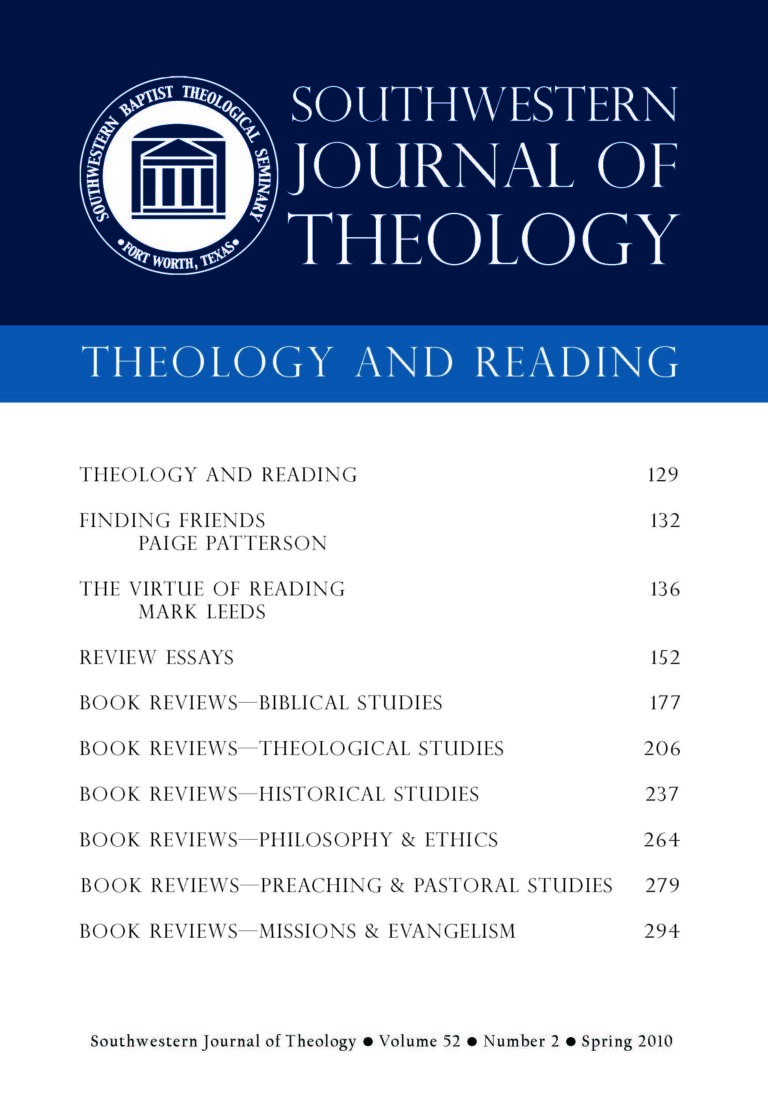
Theology and Reading
Southwestern Journal of Theology
Volume 52, No. 2 – Spring 2010
Managing Editor: Malcolm B. Yarnell III
By Hubertus R. Drobner. Translated by Siegfried S. Schatzmann. Peabody, MA: Hendrickson, 2007. 632 + lvi pages. Hardcover, $44.95.
The title of this work is extremely appropriate; it is indeed “a comprehensive introduction.” Hubertus R. Drobner, Professor for Church History and Patrology of the Theological Faculty at the University of Paderborn, Germany, takes his reader from the formation of the canon to John of Damascus (ca. 650–750). Not only does Drobner span seven centuries of Christian history, but he also concludes his work with a survey of Syriac, Coptic, Ethiopic, Armenian, Georgian, Arabic, and Paleoslavic literature; additionally, that conclusion encompasses literature from the ninth and tenth centuries. Along with a wealth of material, the author provides a nearly all-inclusive bibliography, including general reference works, electronic databases, and translations of patristic works into English, French, German, Italian, and Spanish. Furthermore, this volume includes expansions and updating both in the text and bibliographies. Drobner’s work, therefore, represents a desire for comprehensiveness both in the material covered and in providing the most recent material available.
In this work, the author leaves no stone unturned. For example, he does not leave any doubt as to what he means by the term “church father.” In “Patrology as a Subject,” Drobner explores the meaning of the term “father,” tracing its use in pagan and biblical contexts, as well as in rabbinic understanding. He then provides the traditional definition of what constitutes a writer as a “church father,” along with a discussion of how the era of “church fathers” came to be determined. The section concludes with a discussion of patrology and patristics in general. Encompassing pages 3 through 6, “Patrology as a Subject” serves as an excellent example of the author’s depth, brevity, and clarity when discussing a particular topic.
In his study, Drobner reveals how closely patristic studies are (and need to be) allied with studies of the New Testament. He begins his discussion of biblical apocrypha by exploring the formation of the biblical canon (13–19). That topic helps provide a background for understanding genres of apocryphal literature that followed canonical literary types and arose during the apostolic and postapostolic eras. In this presentation, the author again demonstrates his ability to present a topic with both breadth and depth.
Drobner’s basic format for presenting a particular topic varies according to the nature of the material under consideration. Often, he will have a general discussion commencing a topic. For example, he begins chapter four, “Beginnings of Latin Literature,” with a discussion of Christian Latin (149–51); such an introduction concludes with a listing of works on that particular subject. He then turns to particular fathers, briefly pointing out salient features of their lives, thought, and works, and concludes the presentation for each one with a listing of both primary and secondary works. At other times, he will turn immediately to a church father; in chapter five, “First Phase of Arianism,” the reader immediately encounters Eusebius of Caesarea (223). Whatever approach the author takes, the reader finds a comprehensive list of works for each topic or father, including comprehensive bibliographies, translations, secondary sources, and reference works.
Any reader interested in the patristic era (approximately 100–750) will find Drobner’s patrology an essential text. In its comprehensiveness in all areas it is a complete guide on a myriad of topics. Furthermore, the author’s concise presentation keeps one from becoming bogged down. In approaching this work, however, a reader will do well to go to the index if he or she wishes to explore the complete thought of a particular father. For example, Augustine of Hippo receives a wide-ranging discussion in chapter nine (386–453), including biographical and theological aspects of the North African bishop’s career. Because of Drobner’s arrangement of subject matters, however, a reader interested in Augustine’s writings on monasticism will find those materials present in chapter eight, “Monastic and Hagiographic Literature,” on pages 361 to 365. While Drobner’s discussion may scatter an ancient writer’s thoughts into several different locations, his arrangement by eras and topics helps provide clarity to the major themes and developments in the ancient church’s doctrine. Thanks are due to Siegfried Schatzmann for his success in making Drobner’s patrology available in English.





